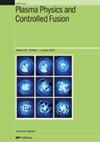利用 EAST 中的下分流器线圈优化对打击点清扫的控制
IF 2.3
2区 物理与天体物理
Q2 PHYSICS, FLUIDS & PLASMAS
引用次数: 0
摘要
2021 年,EAST 配备了全环分流器线圈,以促进对鱼尾分流器概念的研究。最初观察到,线圈电流扫过打击点的能力微乎其微。相反,当交流电的振幅和频率稍有增加时,等离子体控制就会出现明显的中断。造成这种干扰的原因是极性控制场对线圈波动的响应速度有限。为了解决这个问题,我们设计了新的控制方法,以确保使用分流线圈稳定而有效地扫描打击点。所设计的方法有两个方面:在高频打击点控制方面,基于 ISOFLUX 控制策略的低通滤波器去耦技术实现了 100 Hz 的扫描频率。这种策略可实现一致的等离子体管理,而不会影响平均存储能量或密度调节。通过这种对撞击点的熟练操作,可以观察到分流板的峰值温度有所降低。针对低频扫描,开发了一种静态多输入多输出解耦方法,便于同时扫描外侧和内侧打击点。本文章由计算机程序翻译,如有差异,请以英文原文为准。
Optimizing control for strike point sweeping using lower divertor coil in EAST
In 2021, EAST was equipped with a full-ring divertor coil to facilitate research on the fish tail divertor concept. Initially, it was observed that the coil current had a negligible ability to sweep the strike point. Conversely, when the amplitude and frequency of the alternating current were marginally increased, there was a significant interruption to plasma control. This perturbation was attributed to the poloidal control field’s limited response rate to the coil’s fluctuations. To address this issue, novel control methodologies were devised to ensure stable and effective sweeping of the strike point using the divertor coil. The devised methods are twofold: For high-frequency strike point control, a low-pass filter decoupling technique based on ISOFLUX control strategy enabled achieving a sweeping frequency of 100 Hz. This strategy allowed for consistent plasma management without compromising average stored energy or density regulation. Resulting from this proficient manipulation of the strike point, a reduction in the peak temperature of the divertor plate was observed. For low-frequency sweeping, a static multi-input multi-output decoupling approach was developed, facilitating concurrent sweeping of both the outer and inner strike points.
求助全文
通过发布文献求助,成功后即可免费获取论文全文。
去求助
来源期刊

Plasma Physics and Controlled Fusion
物理-物理:核物理
CiteScore
4.50
自引率
13.60%
发文量
224
审稿时长
4.5 months
期刊介绍:
Plasma Physics and Controlled Fusion covers all aspects of the physics of hot, highly ionised plasmas. This includes results of current experimental and theoretical research on all aspects of the physics of high-temperature plasmas and of controlled nuclear fusion, including the basic phenomena in highly-ionised gases in the laboratory, in the ionosphere and in space, in magnetic-confinement and inertial-confinement fusion as well as related diagnostic methods.
Papers with a technological emphasis, for example in such topics as plasma control, fusion technology and diagnostics, are welcomed when the plasma physics is an integral part of the paper or when the technology is unique to plasma applications or new to the field of plasma physics. Papers on dusty plasma physics are welcome when there is a clear relevance to fusion.
 求助内容:
求助内容: 应助结果提醒方式:
应助结果提醒方式:


